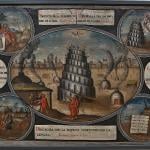 The following press release from the USCCB caught my eye today. Perhaps that’s because I worship in what the release refers to as a “shared parish”, or a church where “two or more languages or cultural contexts are present in the ministerial life of a parish.”
The following press release from the USCCB caught my eye today. Perhaps that’s because I worship in what the release refers to as a “shared parish”, or a church where “two or more languages or cultural contexts are present in the ministerial life of a parish.”
Friday night brought this home for me. I arrived at my parish to attend our Stations of the Cross. The packed parking lot should have been a sign that things weren’t as they usually are. Granted, Stations in our side chapel was literally standing room only, with people spilling out the door. And this was our English stations, since Spanish happens an hour later. But wrapped around the outside of the building was a long line of our Spanish-speaking parishioners waiting to enter the main part of the Church for a special Lenten concert. The place was packed — and honestly the sight of so many people at Church on a Friday night made my heart sing (in both English and Spanish).
In our “shared parish” we learn much from one another. My devotion to not only Spanish devotions, but also to ones from the Philippines, from Portugal and from the Traditional Latin Mass which worships with us weekly have greatly strengthened my prayer life. I’m anxious to read “Best Practices for Shared Parishes: So That They All Might Be One”, but I also believe that my pastor and his team have many best practices already in place.
USCCB Launches Multicultural Parish Resource, Best Practices for ‘Shared Parishes’
Guide is a bilingual resource available in English and Spanish
Responds to dramatic growth in the number of culturally diverse parishes‘Shared Parishes’ are communities with diversity of languages and cultures
March 10, 2014
WASHINGTON—“Best Practices for Shared Parishes: So That They All Might Be One” is the newest resource created by the U.S. Conference of Catholic Bishops (USCCB) Committee on Cultural Diversity in the Church. Its goal is to assist pastors and pastoral teams in welcoming diverse communities and building unity in diversity.
“Population changes are bringing a great deal of diversity to our parishes and dioceses,” said Bishop Daniel Flores of Brownsville, Texas, chairman of the Committee. “The U.S. Catholic bishops recognized this reality in 2007 by making our need to address cultural diversity in the Church one of our top priorities. They also recommended the development of a practical guide to assist pastors of culturally diverse parishes in the challenging task of building up Catholic unity in the midst of such a rich Catholic diversity.”
The number of Catholic parishes shared by culturally diverse communities grew dramatically in the previous decade, going from 22 percent in 2000 to 33 percent in 2010, and all indicators show that this trend will continue in the next decade. Today it is estimated that 6,300 parishes around the country serve ethnic, language and culturally diverse communities. This is due in great part to immigration, but state population changes and parish mergers and closings also play a factor.
The term ‘shared parishes’ describes parish communities in which two or more languages or cultural contexts are present in the ministerial life of a parish. The Committee on Cultural Diversity developed the guide through consultation with pastors that have successfully achieved a high level of ecclesial integration and inclusion among their culturally diverse parishioners. Twenty pastors from different ethnic backgrounds and regions of the country were consulted over a period of 18 months, and three of them oversaw the development of the resource into its final form.
“The guide is a practical tool to assess challenging ministerial situations, identify pastoral responses based on proven best practices, and apply intercultural competencies in the form of attitudes, knowledge, and skills,” said Mar Muñoz-Visoso, executive director of the Secretariat of Cultural Diversity in the Church. “The guide will also help to discern pastoral planning strategies based on integration, inclusion and intercultural sensitivity, which lead to a higher level of stewardship.”
“We are most grateful to the pastors and other experts who helped us to reflect on this topic,” said Muñoz-Visoso. “We hope the resource will be helpful to many communities that are undergoing similar population changes, so that they can reach out and become true missionary disciples in their neighborhood.”
Best Practices for Shared Parishes: So That They All Be One (Pub. No. 7-389) is a bilingual resource in English and Spanish available through the USCCB Bookstore at www.usccbpublishing.org/productdetails.cfm?sku=7-389. The guide was recently introduced at the Mid-Atlantic Congress in Baltimore and it will also be available at the USCCB exhibitor table in the Los Angeles Religious Education Congress in the coming days.
The guide builds on a previous resource called Building Intercultural Competence for Ministers (Pub. No. 7-301), which examines guidelines for intercultural competence in Church settings.
Do you worship in a “shared parish”?











